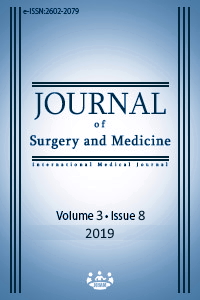Extubation failure in operating room: Review of management in 50 patients at a single center
Keywords:
Extubation, Chronic obstructive pulmonary disease, Congestive heart failure, Perioperative oxygen saturationAbstract
Aim: Postoperative extubation failure is a serious complication of general anesthesia. Prolonged mechanical ventilation is associated with increased morbidity and late mortality. There are numerous factors affecting postoperative extubation failure. In our study, we aimed to evaluate these factors.
Methods: This retrospective cohort study was conducted on 50 patients who could not be extubated postoperatively between January 2016 and January 2019 in Medipol University Medical Faculty Hospital.
Results: The mean age was 61.2 (6.4) (50-77) years. 29 (58%) patients were male and 21 (42%) were female. The mean Body Mass Index was 29.3 (3.6) (12-36) kilogram/square meters (kg/m2). Mean duration of surgery was 240 (27.6) minutes. 39 (78%) patients had chronic obstructive pulmonary disease and 13 (26%) had congestive heart failure. Perioperative oxygen saturation was ≤95% in 44 (88%) patients and >95% in 6 (12%) patients.
Conclusions: Chronic obstructive pulmonary diseases, congestive heart failure and low perioperative oxygen saturation are commonly seen in patients who could not be weaned from mechanical ventilation postoperatively. We advise watching out for patients with these risk factors.
Downloads
References
Acheampong D, Guerrier S, Lavarias V, Pechman D, Mills C, Inabnet W, et al. Unplanned postoperative reintubation following general and vascular surgical procedures: Outcomes and risk factors. Annals of Medicine and Surgery. 2018;33:40–3.
Johnson RG, Arozullah AM, Neumayer L, Henderson WG, Hosokawa P, Khuri SF. Multivariable predictors of postoperative respiratory failure after general and vascular surgery: results from the patient safety in surgery study. J Am Coll Surg. 2007;204:1188-98.
Lee PJ, MacLennan A, Naughton NN, O'Reilly M. An analysis of reintubations from a quality assurance database of 152,000 cases. J Clin Anesth. 2003;15:575-581.
Chinachoti T, Chau-in W, Suraseranivongse S, Kitsampanwong W, Kongrit P. Postoperative reintubation after planned extubation in Thai Anesthesia Incidents Study (THAI Study). J Med Assoc Thai. 2005;88:84-93.
Ting PC, Chou AH, Yang MW, Ho AC, Chang CJ, Chang SC. Postoperative reintubation after planned extubation: A review of 137,866 general anesthetics from 2005 to 2007 in a Medical Center of Taiwan. Acta Anaesthesiologica Taiwanica. 2010;48:167-71.
Marquez-Lara A, Nandyala SV, Fineberg SJ, Singh K. Incidence, outcomes, and mortality of reintubation after anterior cervical fusion. Spine. 2014;39:134–9.
Tillquist MN, Gabriel RA, Dutton RP, Urman RD. Incidence and risk factors for early postoperative reintubations. J. Clin. Anesth. 2016;31:80–9.
Canet J, Mazo V. Postoperative pulmonary complications. Minerva Anestesiol. 2010;76:138–43.
Lawrence VA, Cornell JE, Smetana GW. American College of Physicians. Strategies to reduce postoperative pulmonary complications after noncardiothoracic surgery: systematic review for the American College of Physicians. Ann Intern Med. 2006;8:596–608.
McAlister FA, Khan NA, Straus SE, Papaioakim M, Fisher BW, Majumdar SR, et al. Accuracy of the preoperative assessment in predicting pulmonary risk after nonthoracic surgery. Am J Respir Crit Care Med. 2003;5:741–4.
Tusman G, Böhm SH, Warner DO, Sprung J. Atelectasis and perioperative pulmonary complications in high-risk patients. Curr Opin Anaesthesiol. 2012;1:1–10.
Kindgen-Milles D, Müller E, Buhl R, Böhner H, Ritter D, Sandmann W, et al. Nasal-continuous positive airway pressure reduces pulmonary morbidity and length of hospital stay following thoracoabdominal aortic surgery. Chest. 2005;2:821–8.
Downloads
- 1487 1712
Published
Issue
Section
How to Cite
License
Copyright (c) 2019 Tumay Uludag Yanaral
This work is licensed under a Creative Commons Attribution-NonCommercial-NoDerivatives 4.0 International License.
















